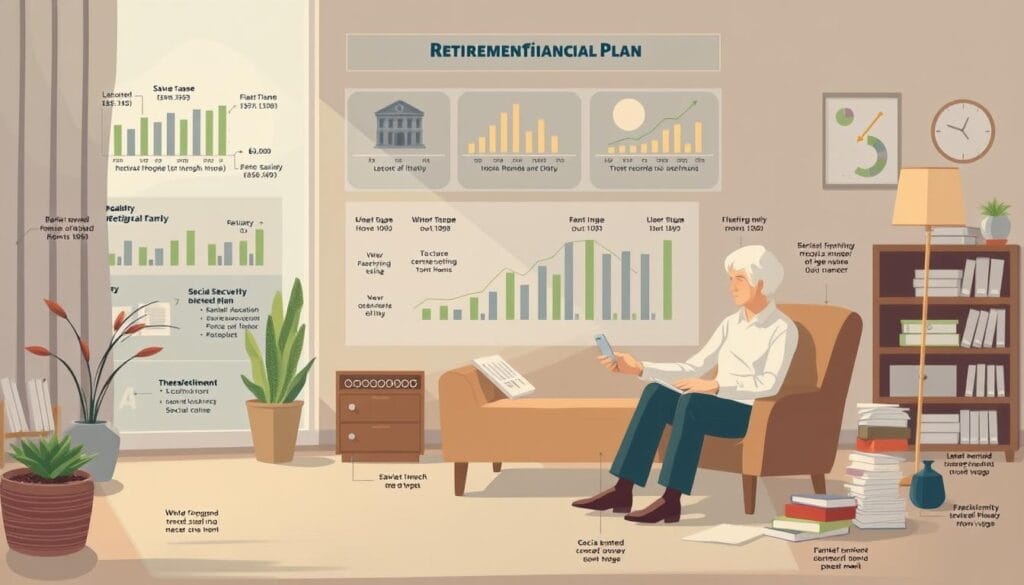Did you know that nearly 50% of retirees deplete their savings within the first five years of retirement? Effective financial planning is crucial to ensure a sustainable income stream throughout retirement.
Retirees face unique challenges, including market volatility, inflation risk, and rising healthcare costs. A comprehensive financial plan helps manage assets, generate income, and protect against unforeseen expenses.
A well-structured approach to retirement finances addresses both immediate needs and long-term goals. By optimizing investment strategies, retirees can make their money last.
Key Takeaways
- Effective financial planning ensures financial security throughout retirement.
- A comprehensive financial plan helps manage assets and generate sustainable income.
- Proper investment allocation balances growth potential with income needs.
- Understanding unique financial challenges retirees face is crucial.
- Professional guidance can optimize retirement income sources and investment strategies.
Understanding Your Current Financial Situation

Assessing your current financial situation is the first step towards securing a stable financial future in retirement. This involves a comprehensive evaluation of your financial standing to create an effective retirement plan.
Assessing Your Net Worth
To determine your net worth, make a list of all your assets, including bank and investment accounts, real estate, and valuable personal property. Then, list all your debts, such as credit cards, mortgages, or student loans. Your assets minus your liabilities equal your net worth, serving as a baseline for framing your financial goals. For more tailored advice, consider using AI-powered tools to get personalized budget advice.
Analyzing Your Income Sources
Identify and categorize all your income sources, including Social Security, pensions, retirement accounts, investments, and any continued employment. Understanding your income streams is crucial for planning your retirement finances effectively.
Evaluating Your Current Expenses
Create a detailed breakdown of your current expenses, distinguishing between essential costs (housing, healthcare, food) and discretionary spending. This will help you understand your cash flow patterns and determine if adjustments are needed for retirement.
| Financial Component | Current Status | Retirement Goal |
|---|---|---|
| Net Worth | $100,000 | $500,000 |
| Income Sources | Social Security, Pension | Maintain or Increase |
| Expenses | $50,000/year | $40,000/year |
Setting Realistic Financial Goals for Retirement

Retirement planning begins with setting clear financial objectives that align with your vision. Establishing financial goals is a crucial step in creating an effective retirement plan. You can’t make a financial plan until you know what you want to accomplish with your money.
Short-Term Financial Objectives
Short-term financial objectives typically focus on immediate needs like building an emergency fund, paying off high-interest debt, or making necessary home repairs. These goals are usually achieved within one to two years. It’s essential to specify a dollar figure and a target date for each goal.
Medium-Term Financial Targets
Medium-term financial targets might include major purchases, travel plans, or helping family members with significant expenses like education. These goals are typically achieved within three to ten years. Prioritizing these goals based on necessity and timeline is crucial.
Long-Term Financial Aspirations
Long-term financial aspirations address your legacy wishes, potential long-term care needs, and ensuring financial security throughout your retirement years. These goals are usually ten or more years away. Regularly revisiting and adjusting your goals as your circumstances evolve is vital.
Creating a Comprehensive Financial Planning Investment Strategy

To secure a stable financial future, creating a comprehensive financial planning investment strategy is vital. This involves several key components that work together to help you achieve your retirement goals.
The Benefits of Having a Written Financial Plan
Having a written financial plan provides numerous benefits, including increased confidence, better decision-making, and the ability to track progress toward specific goals. Only 36% of Americans have a written financial plan, but those who do are more likely to feel in control of their finances.
Determining Your Risk Tolerance
Understanding your personal risk tolerance is crucial for creating an investment strategy that you can maintain through market fluctuations. This involves assessing your time horizon, financial goals, and emotional comfort with market volatility.
Balancing Growth and Income Needs
A comprehensive financial planning investment strategy must balance growth investments needed for longevity protection with income-producing assets required for current expenses. This balance is key to ensuring that your financial resources are managed effectively throughout your retirement.
By working with a financial advisor, you can develop a personalized financial plan that addresses your unique situation and objectives. For more information on planning your retirement with AI-powered financial tools, visit https://aimoneymatters.com/plan-your-retirement-with-ai-powered-financial-tools-in-2025/.
Managing Retirement Income Sources
Creating a sustainable income plan in retirement requires careful consideration of multiple income sources. Effectively managing these sources is essential to ensure that your financial plan supports your lifestyle needs throughout your retirement.
Social Security Optimization Strategies
Strategic approaches to Social Security claiming decisions can significantly impact your lifetime benefits and overall retirement income. For instance, delaying your Social Security benefits can increase your monthly payments. According to the Social Security Administration, delaying benefits until after your full retirement age can result in higher monthly payments.
Pension and 401(k) Distribution Options
Understanding the pros and cons of different pension distribution options, such as lump sum versus annuity payments, is crucial. Navigating 401(k) and IRA withdrawal strategies can help maximize income while minimizing tax implications.
Creating Sustainable Withdrawal Rates
Determining sustainable withdrawal rates from your investment portfolios ensures your money lasts throughout retirement. A coordinated withdrawal strategy across different account types (taxable, tax-deferred, and tax-free) is vital. As a rule of thumb, you’ll need approximately 80% of your present income in retirement, but this can vary based on individual circumstances.
| Income Source | Withdrawal Strategy | Tax Implications |
|---|---|---|
| 401(k) | Systematic withdrawals | Taxed as ordinary income |
| Pension | Annuity payments | Taxed as ordinary income |
| Investments | 4% rule | Capital gains tax |
Expert Insight: “A well-planned retirement income strategy can help ensure that your savings last throughout your retirement.” – Financial Advisor
Investment Strategies for Retirees

As retirees transition into their golden years, their investment strategies must shift to balance income generation, capital preservation, and growth. This phase requires a different approach than during accumulation years, focusing on managing risk while ensuring a steady income stream.
Asset Allocation in Retirement
Determining the optimal asset allocation is crucial based on your time horizon, income needs, risk tolerance, and overall financial situation. Maintaining an appropriate equity allocation provides growth potential that helps combat inflation and extends portfolio longevity.
Fixed Income Investments for Stability
Fixed income investments like bonds, CDs, and annuities can provide stability and reliable income streams in retirement. Strategies for building a bond ladder or creating other structured income approaches can help match anticipated expenses.
Growth Investments for Longevity Protection
The role of dividend-paying stocks and other growth investments is crucial in providing inflation protection and long-term portfolio sustainability. Understanding how sequence of returns risk can impact retirement portfolios and strategies to mitigate this risk is essential.
Regular portfolio rebalancing is vital to maintain your target asset allocation and manage risk exposure. As you progress through different stages of retirement, adjusting your investment strategy to meet changing needs is important.
Managing Risk in Retirement
As you enter retirement, managing risk becomes a crucial aspect of securing your financial future. Effective risk management is critical to ensuring that your retirement savings can withstand unexpected expenses and market fluctuations.
Building an Emergency Fund
One of the key components of managing risk in retirement is building an emergency fund. This fund should cover at least three to six months’ worth of essential living expenses, providing a cushion against unexpected costs such as medical bills or home repairs. It’s generally a good idea to keep this fund in highly liquid, low-risk investments.
Insurance Coverage Considerations
Another vital aspect of risk management is having adequate insurance coverage. This includes health insurance, long-term care insurance, and other types of insurance that can protect against significant expenses.
Health Insurance and Medicare
Understanding your health insurance options is crucial, particularly how Medicare works and what it covers. Medicare doesn’t cover everything, so it’s essential to plan for healthcare costs not covered by insurance.
Long-Term Care Insurance
Long-term care insurance can help protect against the potentially devastating costs of long-term care, such as nursing home or in-home care expenses.
Protecting Against Market Volatility
To protect your retirement savings against market volatility, consider implementing investment strategies such as diversification, asset allocation, and bucket strategies. Regular portfolio reviews and stress testing can also help identify and address potential vulnerabilities in your financial plan.
| Risk Management Strategy | Description | Benefits |
|---|---|---|
| Emergency Fund | Save 3-6 months’ worth of expenses | Covers unexpected costs |
| Insurance Coverage | Health, long-term care, and other insurance | Protects against significant expenses |
| Investment Strategies | Diversification, asset allocation, bucket strategies | Protects against market volatility |
For more information on investment strategies for retirement, you can visit Best Mutual Funds for Retirement in to explore various mutual fund options that can help grow your nest egg.
Tax-Efficient Strategies for Retirees

Tax-efficient strategies are vital for retirees aiming to make the most of their savings and investments. Implementing these strategies can help maximize retirement income and preserve wealth for both current needs and legacy goals.
Tax-Advantaged Account Withdrawals
Understanding the tax treatment of different retirement income sources is crucial. Coordinating withdrawals from taxable, tax-deferred, and tax-free accounts can minimize overall tax burden. For more information on tax-efficient investing, visit Morgan Stanley’s guide.
Managing Required Minimum Distributions
Navigating Required Minimum Distributions (RMDs) from retirement accounts is essential to meet IRS requirements while managing tax implications. Strategies like qualified charitable distributions can help reduce RMD tax impact.
Tax-Loss Harvesting Opportunities
Utilizing tax-loss harvesting opportunities can offset capital gains and potentially reduce overall tax liability. It’s also important to consider tax implications in investment decisions and portfolio management. For insights on Roth IRA providers that can aid in tax-efficient planning, check out AIMoneyMatters.
It’s crucial for retirees to work with tax professionals who specialize in retirement tax planning to navigate complex and changing tax laws. Tax laws are subject to change, and professional advice can help individuals make informed decisions based on their specific situations.
Conclusion: Securing Your Financial Future in Retirement
A secure and fulfilling retirement is within reach when you have a comprehensive financial strategy. Effective financial planning and investment management are crucial for a successful retirement. By taking a comprehensive approach that addresses income generation, risk management, and tax-efficient strategies, you can enjoy peace of mind.
Regularly reviewing and adjusting your financial plan helps you adapt to changing market conditions and personal circumstances. Consider seeking guidance from a financial advisor who specializes in retirement planning to optimize your decisions. For more information on retirement income strategies, visit our resource page. By taking action now, you can secure your financial future and enjoy the retirement lifestyle you’ve worked hard to achieve.

